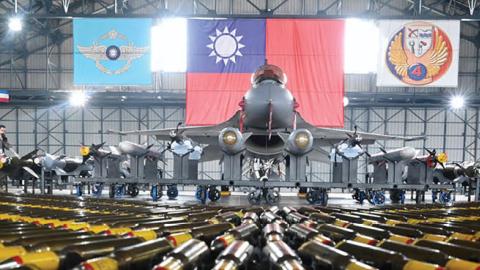The Biden administration’s defense approach recalls the Old West phrase describing a cowboy who talked big without the ability to back it up — “all hat, no cattle.” While the administration has rightly noted the rapidly growing risks to U.S. security, it thus far has neither presented (let alone pursued) a clear strategy nor advocated allocating the resources needed to truly address them.
The reality is that we are at the most dangerous point in our modern history, at least since the Cold War. For the first time since the 1980s, a major war with another superpower — then the USSR, now China — is a real possibility. Even worse, it is quite possible we might lose it. We should be acting to avert this cataclysmic potential outcome with the urgency it clearly deserves. Yet the administration’s defense budget and overall approach exhibit a “business as usual” mindset.
This is discordant, to say the least, with the geopolitical reality we face. The growing Beijing–Moscow axis finds the global military balance shifting away from the United States and its traditional allies at an alarming rate, especially in China’s favor. Beijing, buttressed by the world’s soon-to-be-largest economy, is building a military to eject the United States from Asia and impose its dominance on the region. Meantime, Moscow has openly invaded a neighboring country in the largest act of military aggression in Europe since World War II. Iran aspires to hold sway in the Middle East. North Korea continues expanding its nuclear arsenal, recently testing another ICBM capable of hitting the United States. And jihadi terrorism remains a real threat.
The last time we faced the threat posed by multiple great-power rivals was in World War II. The muscle memory of what dealing with that entailed is now gone, as our national leaders’ reluctance to accept the gravity of the moment is painfully evident. Some cling to the past, seeking comfort under the illusion that the unipolar era still exists — that China’s strength is a mirage and Russia is a paper tiger, albeit with nuclear fangs. Many in this group are comfortable advocating cuts in the nation’s defense budget.
Others do recognize the breadth and scale of the challenge but believe the unipolar era can be restored by an act of will and grit. But it cannot — it is gone with the wind. China in particular but also Russia dwarf the threats posed by minor powers such as Iran and North Korea, not to mention the terrorist groups that dominated Washington’s attention during the period of America’s primacy. In fact, China’s GDP alone is roughly twice as large relative to America’s as was the Soviet Union’s during the Cold War. This is a truly novel situation for the United States, one it has not faced since it became an active great power over a century ago. Yet the administration appears comfortable holding defense budgets at less than half their Cold War–era share of GDP, and significantly below the level funded during America’s unipolar moment, when the threat to national security was far less than it is today. While the president likes to wave a rhetorical big stick, the administration’s proposed budget barely keeps ahead of inflation.
Some might argue that economy is needed, given that the United States’ fiscal standing has declined precipitously over the past two decades, as shown by rapidly mounting public debt and rising inflation. And there is indeed every reason for more fiscal probity. Yet we will not have a free and secure prosperity if we neglect the world around us, especially if China is able to secure dominance over the world’s largest market area. And in any case, this point rings hollow when the administration is calling for ever-greater spending on a laundry list of domestic wants without an eye toward how to responsibly fund such increases. Meanwhile, key allies talk of enhancing their defenses but have habitually failed to back their words with action.
Nor can we just hope that time will solve our problems. The United States has seen not only its long-standing advantage in economic scale over its rivals diminish dramatically, but also its lead in key technologies that are the foundation of long-term economic growth and military might. And, as is not the case in China, where a fervent patriotism is on the rise, many Americans seem keen to embrace an attitude of unwarrantable self-abasement. Indeed, a recent poll suggested that a large portion of Americans would not fight to defend their country if it were attacked. Under such conditions, notions of returning to a unipolar era are moonshine.
Put simply, the Biden administration’s approach combines the worst of both schools of thought. The president talks of an existential “battle” between democracy and authoritarianism, but he embraces the budgets of those who ignore the growing dangers to America’s security. He talks like JFK, but when it comes to backing it up with a clear strategy supported by adequate funding for defense, he walks like Jimmy Carter. The result is a growing gap between the country’s security and the means provided to achieve it. One might call it a strategy of hope: The administration sets security goals that it cannot realistically achieve at anything approaching an acceptable level of risk, given the resources being made available.
First of all, while it is a pipedream to think we can spend our way back to the multi-theater strategic and military dominance that we enjoyed in the wake of the collapse of the Soviet Union, we can take steps to resolve this ends–means imbalance and provide for America’s security at a reasonable level of risk. This means investing in our defenses with the resources necessary to keep pace with the deepening threats to our security, above all China.
Second, as resources are limited, strategy is very much about making hard choices. This is important because increases in defense will not relieve us of the need to set priorities regarding those threats that pose the greatest dangers, and in the size, types, posture, and employment of military forces that can best address them. To be sure, Russian aggression in Europe and the dangers posed by North Korea and Iran cannot be ignored. Yet China — by virtue of its economic might and broad-based military buildup — stands as far and away the most serious threat to America’s security. The Indo-Pacific region, and especially the Western Pacific, is, and will remain over the foreseeable future, the decisive theater of geostrategic competition.
Accordingly, the United States must pivot its overall defense buildup to the Western Pacific. Unlike its earlier incarnations, however, this shift must actually be implemented. Obama’s “pivot” was mostly rhetorical, while Trump’s shift to Asia lagged in its implementation. We can no longer afford to defer action. Rather, we must actively work to build and sustain a coalition in Asia to block China’s bid for hegemony, focusing on Australia, India, Indonesia, Japan, the Philippines, South Korea, Taiwan, and Vietnam. To enable and support this coalition, the United States must ensure a U.S.-and-allied military posture in Asia that is sufficient to deny China’s ability to subordinate U.S. allies, including Taiwan. Anything less will only encourage further Chinese expansion, and quite likely aggression, while discouraging the efforts of America’s allies and prospective partners to enhance their defenses. At the same time, we should bolster and accelerate efforts by our European allies and the Abraham Accord coalition to augment their defenses to speed our reorientation to the Indo-Pacific.
Third, the U.S. military must adapt to changes in the character of warfare. For starters, this means accepting that its near monopoly in precision warfare, which it introduced during the first Gulf War, is finding its match in China’s large-scale military-modernization effort, now in its third decade. Advances in artificial intelligence, directed energy, hypersonic weaponry, cyber payloads, and advanced robotics promise to stimulate even more disruptive shifts in the mili-tary competition.
Critically, though, this cannot mean ignoring near-term requirements. We are past the point where the United States could “take a knee” by reducing the readiness of its military to modernize for a more distant threat. The Chinese threat is indeed a long-term and overriding strategic challenge — but it is also an immediate one. Indeed, many defense experts fear that, barring major improvements in our collective defenses, China may be capable of successfully assaulting and occupying Taiwan by mid decade. Consequently, the Pentagon must therefore move expeditiously to establish effective defenses in the Western Pacific in both the near and the longer term.
Fourth, the administration must require the U.S. military to provide a clear statement of its “operational concepts” — how it plans to accomplish its core missions, above all with respect to the threats posed by China, and align its defense budget and activities accordingly. Yet today there is no clear sense as to how we plan to actually defend our allies along the crucial first island chain in the Western Pacific — of which the most vulnerable is Taiwan. Efforts by administrations over the past decade to arrive at an answer have failed to yield anything more than generic responses that provide little insight into how to set and evaluate defense-program priorities. This has to change. The alternative will find us investing increasingly in a military designed to deter and win yesterday’s wars rather than tomorrow’s.
Accomplishing these objectives will not be easy. Nor will doing so restore America’s globe-spanning dominance. At best, it will arrest the growing danger to the nation’s security and, with luck, reduce it over time. But the alternative is unthinkably worse — a world dominated by China and its authoritarian sidekicks. Avoiding that must be our principal national-security priority.
Read in National Review




















